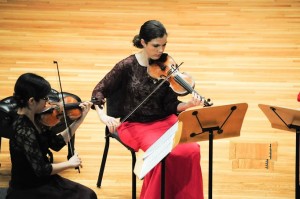The Momenta Quartet of the Princeton Symphony Orchestra performed “Momenta in Motion” on Thursday, Jan. 23, in Mayo Concert Hall, featuring both classical and contemporary compositions that held Spanish influences.

The Quartet consisted of violist Stephanie Griffin, cellist Michael Haas and violinists Emilie-Anne Gendron and Adda Kridler.
Momenta opened with Joseph Haydn’s “String Quartet in E-flat Major, Op. 20, No. 1.” The piece consisted of four movements.
The first movement, “Allegro Moderato,” held playful, high-registered notes with a mischievous undertone from the violins. The second and third movement, “Minuetto: Allegretto and Affettuoso e sostenuto,” held deeper and richer tones from the cello that added to the rise and fall of the piece. The final movement, “Finale: Presto,” mirrored the first, holding similar whimsical tones.
After a round of applause, the quartet dove into Agustín Fernández’s “String Quartet No. 2, ‘Sin tiempo.”’ The composition was commissioned for Momenta by the Koussevity Foundation.
“This piece is something you have never heard before,” violist Stephanie Griffin said. “We first premiered this piece at Williams College last November. This will be the New Jersey premiere.”
Fernández was a Bolivian composer who spent time living in both Japan and England. As a modernist who embraced a variety of cultures, Fernández’s music is lively with latin rhythms and folk influences.
The performed piece was essentially based on a Spanish prayer, but unlike most prayer compositions, this one was not mystical and held remnants of historical influences from libertarian theology and guerrilla warfare. The idea behind this prayer was repetition — to say the word until the meaning is revealed.
Soft but fierce and rapid notes filled the room, coupled with breaks and adding suspense during the first movement of the composition, “Profecía” or the “Prophecy.”
While the piece allowed all four of them to take the helm of the composition, it really highlighted the cello during the second movement, “Plegaria” or “Prayer.”
The cello bellowed long, deep and repetitive notes, emulating the prayer, while the smaller stringed instruments buzzed in the background, almost symbolizing the confusion and struggle of the voice behind the prayer. The closing movement, “Accion,” incorporated really diverse and experimental sounds that ranged from high to low chords and overlapped with plucked strings from all of the instruments.
After intermission, Momenta performed Tomás Luis de Victoria’s “Quam pulchri sunt in Conceptione Beatæ Mariæ.” This Spanish influenced piece is revered as being very sensual.
The quartet then closed with Claude Debussy’s “String Quartet in G Minor, Op. 10.”
“Debussy is the forerunner of modernism,” violinist Emilie-Anne Gendron said.
All four movements of the composition continued with the concert’s Spanish-melodic theme. The piece featured different rhythmic and textured effects, which highlighted each performer, switching the audience’s focus with fluidity.
“The group undeniably has raw talent,” said Zachary Elliott, sophomore history and classical studies double major. “They have such a diverse sound and range. It really is beautiful.”
As a new partner with the College, the Princeton Symphony Orchestra will return to campus on Thursday, March 6, with a vocal octet and then again on Saturday, March 29, for a “Classical Series: Night and Dreams.”






